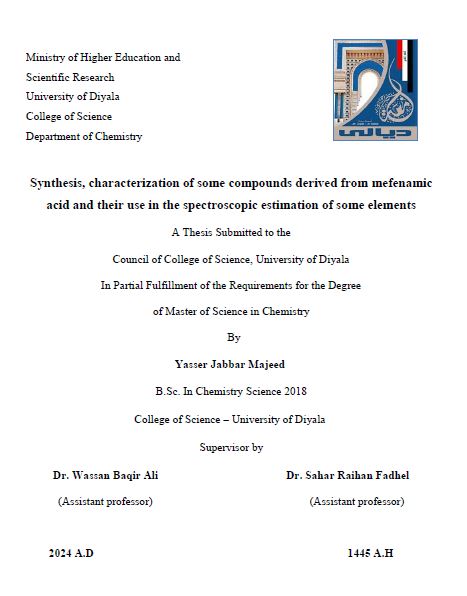Abstract
The new compounds from mefenamic acid were prepared, The chemical structures of the prepared compounds Y1-Y4 were determined by some spectroscopy techniques such as FTIR,1HNMR. The reactions were followed by thin layer chromatography (TLC) to ensure that the preparation of these compounds is complete and their purity, some physical properties of prepared compounds were recorded such as melting points and colours.
The current study included some steps:
- The Compound (Y1) were synthesized through the reaction of Hydrazine Hydrate with carbon sulfide.
- The Compound (Y2) were synthesized through the reaction of mefenamic acid with thiocarbohydrazide.
- Compound (Y3) was synthesized through the reaction of 4-amino-5-(2-((2,3-dimethylphenyl)amino)phenyl)-4H-1,2,4-triazole-3-thiol [Y2] with 3-nitrophenol while the Compound (Y4 ) was synthesized through the reaction of 4-amino-5-(2-((2,3-dimethylphenyl)amino)phenyl)-4H-1,2,4-triazole-3-thiol [Y2] with 4-hydroxy-3-methoxybenzaldehyde.
In addition, the study included the use of Compounds Y3, Y4 in the spectral estimation of the following elements, Fe (III), Co (II), Ni (II) and Cd (II).
It included the composition of equipment for each ion with the elements used and the study of the optimal conditions for each complex:
- Determination of Fe (III) ion with the reagent [Y3] at λmax=545 nm was found the optimum conditions, the volume of reagent at 2.0 mL, coupling reaction time at 10 min, the temperature at 25 ºC, The stability at 5 min, the calibration curve shows that the (R2=0.9931), apparent molar absorptivity ( ε) was 24963.2 L.mol-1.cm-1, Sandell’s sensitivity was 0.0431 µg.cm-2. Also Job’s continuous variation methods and molar ratio were determined and it was 1:2.
- Determination of Co (II) ion with the reagent [Y3] at λmax=532 nm was found optimum reagent volume at 2.0 mL, optimum coupling reaction time at 10 min, optimum temperature at 25 ºC, The optimum stability at 10 min, the calibration curve show that the (R2=0.9978), apparent molar absorptivity (ε) was 23930.4 L.mol-1.cm-1, Sandell’s sensitivity was 0.0423 µg.cm-2. Also Job’s continuous variation methods and molar ratio were determine and it was 1:2.
- Determination of Ni (II) ion with the reagent [Y4] at λmax=664 nm was found optimum reagent volume at 1.0 mL, optimum coupling reaction time at 5 min, optimum temperature at 25 ºC, The optimum stability at 5 min, the calibration curve show that the (R2=0.9733), apparent molar absorptivity (ε) was 25192 L.mol-1.cm-1, Sandell’s sensitivity was 0.0425 µg.cm-2. Also Job’s continuous variation methods and molar ratio were determined and it was 1:2.
- Determination of Cd (II) ion with the reagent [Y4] at λmax=460 nm was found optimum reagent volume at 2.0 mL, optimum sodium hydroxide volume at 1.0 mL, optimum coupling reaction time at 5 min, optimum temperature at 25 ºC, The optimum stability at 5 min, the calibration curve show that the (R2=0.9948), apparent molar absorptivity (ε) was 9540.8 L.mol-1.cm-1, Sandell’s sensitivity was 0.1123 µg.cm-2. Also Job’s continuous variation methods and molar ratio were determined and it was 1:2.
It was applied for quantification of of Fe(III), Co(II), Ni(II) and Cd(II) ions in tap water samples (drinking water system in June), river water (Diyala River), industrial wastewater from the Diyala Electrical Industry Company (industrial wastewater from Electrical manufacturing factory) and bottle of juice in the local markets in Baquba, were collected from , Baquba (Diyala, Iraq) and stored in the refrigerator up to use without any pretreatment. To check the existence of studied ions and determine their concentration in various real water samples, they were analyzed without spiking. According to the results, the presence of the studied ions was not observed in samples of tap water, and juice, while a significant concentration of these ions was observed in Diyala River water and the company’s industrial wastewater.





